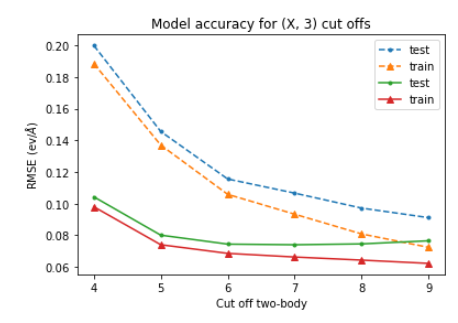I am trying to get force constant for phono3py calculations. I am wondering what is the target force errors to aim for.
My system is a rutile structured ionic crystal. The force errors that I can get to is around 90- 200 meV/A, using longer ranged 2 body interactions seems to reduce the error towards the lower end (100 meV/A).
In the hiphive paper and other examples, the error on the forces seems to be much lower.
I also tried to separate long-range and short-range interactions following the example in the tutorial, but with the long range substracted the RMSE of the forces increases instead (this is normal?).
Here is an example of the output, using [7, 3] (least-squares):
===================== Optimizer ======================
seed : 42
fit_method : least-squares
standardize : True
n_target_values : 57600
n_parameters : 5173
n_nonzero_parameters : 5173
parameters_norm : 616.2072
target_values_std : 1.406111
rmse_train : 0.09352622
rmse_test : 0.105613
R2_train : 0.9955674
R2_test : 0.9944533
AIC : -235325.2
BIC : -189513.5
train_size : 51840
test_size : 5760
======================================================
With substracted LR contribution (using a smaller cell size):
===================== Optimizer ======================
seed : 199
fit_method : least-squares
standardize : True
n_target_values : 34560
n_parameters : 5173
n_nonzero_parameters : 5173
parameters_norm : 626.8203
target_values_std : 1.352439
rmse_train : 0.2403686
rmse_test : 0.2822997
R2_train : 0.9683434
R2_test : 0.9572655
AIC : -78336.59
BIC : -35167.43
train_size : 31104
test_size : 3456
======================================================
